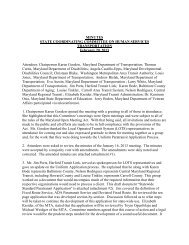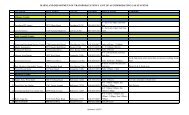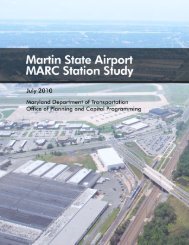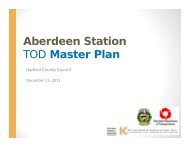PB PlaceMaking - Maryland Department of Transportation
PB PlaceMaking - Maryland Department of Transportation
PB PlaceMaking - Maryland Department of Transportation
You also want an ePaper? Increase the reach of your titles
YUMPU automatically turns print PDFs into web optimized ePapers that Google loves.
Implementation Strategy<br />
Challenges Presented by the Strategy<br />
The State Center TOD Strategy outlines how a 110-acre area in<br />
the center <strong>of</strong> Baltimore can be revitalized to stimulate economic<br />
development, increase employment, provide a diverse range<br />
<strong>of</strong> housing options, and enhance local fiscal revenues. The<br />
Strategy will catalyze development <strong>of</strong> a new thriving mixeduse<br />
neighborhood that is integrated with and supports adjacent<br />
neighborhoods. The proposed development program will attract<br />
substantial new private investment to the area, and sufficient new<br />
revenues to repay required supporting public investment.<br />
The Strategy, while feasible from a market and financial perspective,<br />
still faces significant hurdles that must be addressed before it can be<br />
successfully implemented. These include:<br />
˚ Multiple Institutional Owners – The State <strong>of</strong> <strong>Maryland</strong> and the<br />
Housing Authority <strong>of</strong> Baltimore City own a majority <strong>of</strong> the land<br />
in the study area. These agencies have their own mandates<br />
and institutional objectives that do not necessarily mesh with<br />
market considerations or investor expectations. The plans<br />
and actions <strong>of</strong> other large land owners in the area, such as the<br />
University <strong>of</strong> <strong>Maryland</strong> and the Baltimore City Public School<br />
System, also affect this Strategy. Coordination <strong>of</strong> decisionmaking<br />
by these institutional owners is necessary for the<br />
Strategy to succeed.<br />
˚ Creative Financing Techniques – The financial analysis shows<br />
that there is a need for significant public investment to fund<br />
infrastructure and capital improvement costs. Although many<br />
<strong>of</strong> the funding sources appear to be potentially available,<br />
efforts will be required to obtain them, as well as determine<br />
the optimal mix <strong>of</strong> TIF bonds, Payments-in-Lieu <strong>of</strong> Taxes<br />
(PILOT), and other potential City, state, and federal funding<br />
sources.<br />
˚ Parking Management – The Strategy calls for more parking to<br />
be provided than is required by City codes to meet investor<br />
expectations and lessen potential impacts. At the same time,<br />
it assumes that the various uses and their locations can be<br />
chosen to <strong>of</strong>fset peak parking requirements and reduce the<br />
number <strong>of</strong> needed spaces. The phasing and operation <strong>of</strong><br />
parking will require careful coordination by an experienced<br />
and empowered entity.<br />
˚ Need for Innovative Partnerships – The institutional, financing,<br />
and parking challenges, as well as overlapping City and State<br />
jurisdictions suggest the need for an innovative approach to<br />
implementation <strong>of</strong> this TOD Strategy.<br />
State Center Transit Oriented Development Strategy 49









